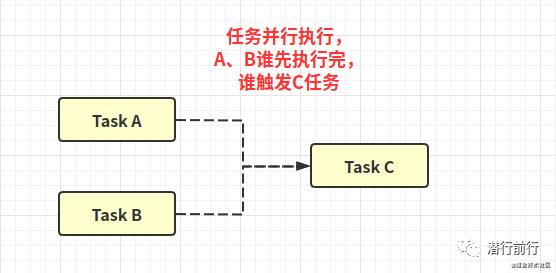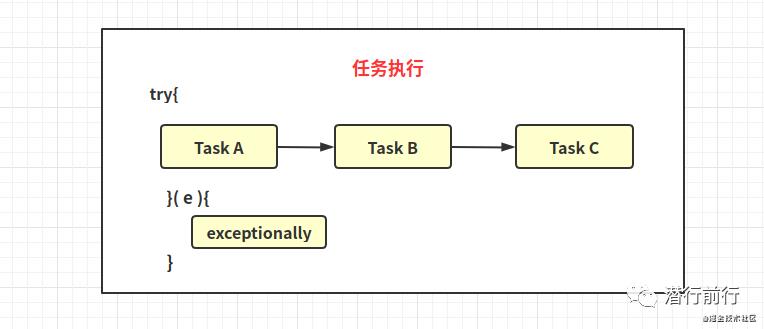基础篇:异步编程不会?我教你啊!CompeletableFuture
Posted 潜行前行
tags:
篇首语:本文由小常识网(cha138.com)小编为大家整理,主要介绍了基础篇:异步编程不会?我教你啊!CompeletableFuture相关的知识,希望对你有一定的参考价值。
前言
以前需要异步执行一个任务时,一般是用Thread或者线程池Executor去创建。如果需要返回值,则是调用Executor.submit获取Future。但是多个线程存在依赖组合,我们又能怎么办?可使用同步组件CountDownLatch、CyclicBarrier等;其实有简单的方法,就是用CompeletableFuture
-
线程任务的创建 -
线程任务的串行执行 -
线程任务的并行执行 -
处理任务结果和异常 -
多任务的简单组合 -
取消执行线程任务 -
任务结果的获取和完成与否判断
1 创建异步线程任务
根据supplier创建CompletableFuture任务
//使用内置线程ForkJoinPool.commonPool(),根据supplier构建执行任务
public static <U> CompletableFuture<U> supplyAsync(Supplier<U> supplier)
//指定自定义线程,根据supplier构建执行任务
public static <U> CompletableFuture<U> supplyAsync(Supplier<U> supplier, Executor executor)
根据runnable创建CompletableFuture任务
//使用内置线程ForkJoinPool.commonPool(),根据runnable构建执行任务
public static CompletableFuture<Void> runAsync(Runnable runnable)
//指定自定义线程,根据runnable构建执行任务
public static CompletableFuture<Void> runAsync(Runnable runnable, Executor executor)
-
使用示例
ExecutorService executor = Executors.newSingleThreadExecutor();
CompletableFuture<Void> rFuture = CompletableFuture
.runAsync(() -> System.out.println("hello siting"), executor);
//supplyAsync的使用
CompletableFuture<String> future = CompletableFuture
.supplyAsync(() -> {
System.out.print("hello ");
return "siting";
}, executor);
//阻塞等待,runAsync 的future 无返回值,输出null
System.out.println(rFuture.join());
//阻塞等待
String name = future.join();
System.out.println(name);
executor.shutdown(); // 线程池需要关闭
--------输出结果--------
hello siting
null
hello siting
常量值作为CompletableFuture返回
//有时候是需要构建一个常量的CompletableFuture
public static <U> CompletableFuture<U> completedFuture(U value)
2 线程串行执行
任务完成则运行action,不关心上一个任务的结果,无返回值
public CompletableFuture<Void> thenRun(Runnable action)
public CompletableFuture<Void> thenRunAsync(Runnable action)
public CompletableFuture<Void> thenRunAsync(Runnable action, Executor executor)
-
使用示例
CompletableFuture<Void> future = CompletableFuture
.supplyAsync(() -> "hello siting", executor)
.thenRunAsync(() -> System.out.println("OK"), executor);
executor.shutdown();
--------输出结果--------
OK
任务完成则运行action,依赖上一个任务的结果,无返回值
public CompletableFuture<Void> thenAccept(Consumer<? super T> action)
public CompletableFuture<Void> thenAcceptAsync(Consumer<? super T> action)
public CompletableFuture<Void> thenAcceptAsync(Consumer<? super T> action, Executor executor)
-
使用示例
ExecutorService executor = Executors.newSingleThreadExecutor();
CompletableFuture<Void> future = CompletableFuture
.supplyAsync(() -> "hello siting", executor)
.thenAcceptAsync(System.out::println, executor);
executor.shutdown();
--------输出结果--------
hello siting
任务完成则运行fn,依赖上一个任务的结果,有返回值
public <U> CompletableFuture<U> thenApply(Function<? super T,? extends U> fn)
public <U> CompletableFuture<U> thenApplyAsync(Function<? super T,? extends U> fn)
public <U> CompletableFuture<U> thenApplyAsync(Function<? super T,? extends U> fn, Executor executor)
-
使用示例
ExecutorService executor = Executors.newSingleThreadExecutor();
CompletableFuture<String> future = CompletableFuture
.supplyAsync(() -> "hello world", executor)
.thenApplyAsync(data -> {
System.out.println(data); return "OK";
}, executor);
System.out.println(future.join());
executor.shutdown();
--------输出结果--------
hello world
OK
thenCompose - 任务完成则运行fn,依赖上一个任务的结果,有返回值
-
类似thenApply(区别是thenCompose的返回值是CompletionStage,thenApply则是返回 U),提供该方法为了和其他CompletableFuture任务更好地配套组合使用
public <U> CompletableFuture<U> thenCompose(Function<? super T, ? extends CompletionStage<U>> fn)
public <U> CompletableFuture<U> thenComposeAsync(Function<? super T, ? extends CompletionStage<U>> fn)
public <U> CompletableFuture<U> thenComposeAsync(Function<? super T, ? extends CompletionStage<U>> fn,
Executor executor)
-
使用示例
//第一个异步任务,常量任务
CompletableFuture<String> f = CompletableFuture.completedFuture("OK");
//第二个异步任务
ExecutorService executor = Executors.newSingleThreadExecutor();
CompletableFuture<String> future = CompletableFuture
.supplyAsync(() -> "hello world", executor)
.thenComposeAsync(data -> {
System.out.println(data); return f; //使用第一个任务作为返回
}, executor);
System.out.println(future.join());
executor.shutdown();
--------输出结果--------
hello world
OK
3 线程并行执行

两个CompletableFuture[并行]执行完,然后执行action,不依赖上两个任务的结果,无返回值
public CompletableFuture<Void> runAfterBoth(CompletionStage<?> other, Runnable action)
public CompletableFuture<Void> runAfterBothAsync(CompletionStage<?> other, Runnable action)
public CompletableFuture<Void> runAfterBothAsync(CompletionStage<?> other, Runnable action, Executor executor)
-
使用示例
//第一个异步任务,常量任务
CompletableFuture<String> first = CompletableFuture.completedFuture("hello world");
ExecutorService executor = Executors.newSingleThreadExecutor();
CompletableFuture<Void> future = CompletableFuture
//第二个异步任务
.supplyAsync(() -> "hello siting", executor)
// () -> System.out.println("OK") 是第三个任务
.runAfterBothAsync(first, () -> System.out.println("OK"), executor);
executor.shutdown();
--------输出结果--------
OK
两个CompletableFuture[并行]执行完,然后执行action,依赖上两个任务的结果,无返回值
//第一个任务完成再运行other,fn再依赖消费两个任务的结果,无返回值
public <U> CompletableFuture<Void> thenAcceptBoth(CompletionStage<? extends U> other,
BiConsumer<? super T, ? super U> action)
//两个任务异步完成,fn再依赖消费两个任务的结果,无返回值
public <U> CompletableFuture<Void> thenAcceptBothAsync(CompletionStage<? extends U> other,
BiConsumer<? super T, ? super U> action)
//两个任务异步完成(第二个任务用指定线程池执行),fn再依赖消费两个任务的结果,无返回值
public <U> CompletableFuture<Void> thenAcceptBothAsync(CompletionStage<? extends U> other,
BiConsumer<? super T, ? super U> action, Executor executor)
-
使用示例
//第一个异步任务,常量任务
CompletableFuture<String> first = CompletableFuture.completedFuture("hello world");
ExecutorService executor = Executors.newSingleThreadExecutor();
CompletableFuture<Void> future = CompletableFuture
//第二个异步任务
.supplyAsync(() -> "hello siting", executor)
// (w, s) -> System.out.println(s) 是第三个任务
.thenAcceptBothAsync(first, (s, w) -> System.out.println(s), executor);
executor.shutdown();
--------输出结果--------
hello siting
两个CompletableFuture[并行]执行完,然后执行action,依赖上两个任务的结果,有返回值
//第一个任务完成再运行other,fn再依赖消费两个任务的结果,有返回值
public <U,V> CompletableFuture<V> thenCombine(CompletionStage<? extends U> other,
BiFunction<? super T,? super U,? extends V> fn)
//两个任务异步完成,fn再依赖消费两个任务的结果,有返回值
public <U,V> CompletableFuture<V> thenCombineAsync(CompletionStage<? extends U> other,
BiFunction<? super T,? super U,? extends V> fn)
//两个任务异步完成(第二个任务用指定线程池执行),fn再依赖消费两个任务的结果,有返回值
public <U,V> CompletableFuture<V> thenCombineAsync(CompletionStage<? extends U> other,
BiFunction<? super T,? super U,? extends V> fn, Executor executor)
-
使用示例
//第一个异步任务,常量任务
CompletableFuture<String> first = CompletableFuture.completedFuture("hello world");
ExecutorService executor = Executors.newSingleThreadExecutor();
CompletableFuture<String> future = CompletableFuture
//第二个异步任务
.supplyAsync(() -> "hello siting", executor)
// (w, s) -> System.out.println(s) 是第三个任务
.thenCombineAsync(first, (s, w) -> {
System.out.println(s);
return "OK";
}, executor);
System.out.println(future.join());
executor.shutdown();
--------输出结果--------
hello siting
OK
4 线程并行执行,谁先执行完则谁触发下一任务(二者选其最快)

上一个任务或者other任务完成, 运行action,不依赖前一任务的结果,无返回值
public CompletableFuture<Void> runAfterEither(CompletionStage<?> other, Runnable action)
public CompletableFuture<Void> runAfterEitherAsync(CompletionStage<?> other, Runnable action)
public CompletableFuture<Void> runAfterEitherAsync(CompletionStage<?> other,
Runnable action, Executor executor)
-
使用示例
//第一个异步任务,休眠1秒,保证最晚执行晚
CompletableFuture<String> first = CompletableFuture.supplyAsync(()->{
try{ Thread.sleep(1000); }catch (Exception e){}
System.out.println("hello world");
return "hello world";
});
ExecutorService executor = Executors.newSingleThreadExecutor();
CompletableFuture<Void> future = CompletableFuture
//第二个异步任务
.supplyAsync(() ->{
System.out.println("hello siting");
return "hello siting";
} , executor)
//() -> System.out.println("OK") 是第三个任务
.runAfterEitherAsync(first, () -> System.out.println("OK") , executor);
executor.shutdown();
--------输出结果--------
hello siting
OK
上一个任务或者other任务完成, 运行action,依赖最先完成任务的结果,无返回值
public CompletableFuture<Void> acceptEither(CompletionStage<? extends T> other,
Consumer<? super T> action)
public CompletableFuture<Void> acceptEitherAsync(CompletionStage<? extends T> other,
Consumer<? super T> action, Executor executor)
public CompletableFuture<Void> acceptEitherAsync(CompletionStage<? extends T> other,
Consumer<? super T> action, Executor executor)
-
使用示例
//第一个异步任务,休眠1秒,保证最晚执行晚
CompletableFuture<String> first = CompletableFuture.supplyAsync(()->{
try{ Thread.sleep(1000); }catch (Exception e){}
return "hello world";
});
ExecutorService executor = Executors.newSingleThreadExecutor();
CompletableFuture<Void> future = CompletableFuture
//第二个异步任务
.supplyAsync(() -> "hello siting", executor)
// data -> System.out.println(data) 是第三个任务
.acceptEitherAsync(first, data -> System.out.println(data) , executor);
executor.shutdown();
--------输出结果--------
hello siting
上一个任务或者other任务完成, 运行fn,依赖最先完成任务的结果,有返回值
public <U> CompletableFuture<U> applyToEither(CompletionStage<? extends T> other,
Function<? super T, U> fn)
public <U> CompletableFuture<U> applyToEitherAsync(CompletionStage<? extends T> other,
Function<? super T, U> fn)
public <U> CompletableFuture<U> applyToEitherAsync(CompletionStage<? extends T> other,
Function<? super T, U> fn, Executor executor)
-
使用示例
//第一个异步任务,休眠1秒,保证最晚执行晚
CompletableFuture<String> first = CompletableFuture.supplyAsync(()->{
try{ Thread.sleep(1000); }catch (Exception e){}
return "hello world";
});
ExecutorService executor = Executors.newSingleThreadExecutor();
CompletableFuture<String> future = CompletableFuture
//第二个异步任务
.supplyAsync(() -> "hello siting", executor)
// data -> System.out.println(data) 是第三个任务
.applyToEitherAsync(first, data -> {
System.out.println(data);
return "OK";
} , executor);
System.out.println(future);
executor.shutdown();
--------输出结果--------
hello siting
OK
5 处理任务结果或者异常
exceptionally-处理异常

public CompletableFuture<T> exceptionally(Function<Throwable, ? extends T> fn)
-
如果之前的处理环节有异常问题,则会触发exceptionally的调用相当于 try...catch -
使用示例
CompletableFuture<Integer> first = CompletableFuture
.supplyAsync(() -> {
if (true) {
throw new RuntimeException("main error!");
}
return "hello world";
})
.thenApply(data -> 1)
.exceptionally(e -> {
e.printStackTrace(); // 异常捕捉处理,前面两个处理环节的日常都能捕获
return 0;
});
handle-任务完成或者异常时运行fn,返回值为fn的返回
-
相比exceptionally而言,即可处理上一环节的异常也可以处理其正常返回值
public <U> CompletableFuture<U> handle(BiFunction<? super T, Throwable, ? extends U> fn)
public <U> CompletableFuture<U> handleAsync(BiFunction<? super T, Throwable, ? extends U> fn)
public <U> CompletableFuture<U> handleAsync(BiFunction<? super T, Throwable, ? extends U> fn,
Executor executor)
-
使用示例
CompletableFuture<Integer> first = CompletableFuture
.supplyAsync(() -> {
if (true) { throw new RuntimeException("main error!"); }
return "hello world";
})
.thenApply(data -> 1)
.handleAsync((data,e) -> {
e.printStackTrace(); // 异常捕捉处理
return data;
});
System.out.println(first.join());
--------输出结果--------
java.util.concurrent.CompletionException: java.lang.RuntimeException: main error!
... 5 more
null
whenComplete-任务完成或者异常时运行action,有返回值
-
whenComplete与handle的区别在于,它不参与返回结果的处理,把它当成监听器即可 -
即使异常被处理,在CompletableFuture外层,异常也会再次复现 -
使用whenCompleteAsync时,返回结果则需要考虑多线程操作问题,毕竟会出现两个线程同时操作一个结果
public CompletableFuture<T> whenComplete(BiConsumer<? super T, ? super Throwable> action)
public CompletableFuture<T> whenCompleteAsync(BiConsumer<? super T, ? super Throwable> action)
public CompletableFuture<T> whenCompleteAsync(BiConsumer<? super T, ? super Throwable> action,
Executor executor)
-
使用示例
CompletableFuture<AtomicBoolean> first = CompletableFuture
.supplyAsync(() -> {
if (true) { throw new RuntimeException("main error!"); }
return "hello world";
})
.thenApply(data -> new AtomicBoolean(false))
.whenCompleteAsync((data,e) -> {
//异常捕捉处理, 但是异常还是会在外层复现
System.out.println(e.getMessage());
});
first.join();
--------输出结果--------
java.lang.RuntimeException: main error!
Exception in thread "main" java.util.concurrent.CompletionException: java.lang.RuntimeException: main error!
... 5 more
6 多个任务的简单组合
public static CompletableFuture<Void> allOf(CompletableFuture<?>... cfs)
public static CompletableFuture<Object> anyOf(CompletableFuture<?>... cfs)
-
使用示例
CompletableFuture<Void> future = CompletableFuture
.allOf(CompletableFuture.completedFuture("A"),
CompletableFuture.completedFuture("B"));
//全部任务都需要执行完
future.join();
CompletableFuture<Object> future2 = CompletableFuture
.anyOf(CompletableFuture.completedFuture("C"),
CompletableFuture.completedFuture("D"));
//其中一个任务行完即可
future2.join();
8 取消执行线程任务
// mayInterruptIfRunning 无影响;如果任务未完成,则返回异常
public boolean cancel(boolean mayInterruptIfRunning)
//任务是否取消
public boolean isCancelled()
-
使用示例
CompletableFuture<Integer> future = CompletableFuture
.supplyAsync(() -> {
try { Thread.sleep(1000); } catch (Exception e) { }
return "hello world";
})
.thenApply(data -> 1);
System.out.println("任务取消前:" + future.isCancelled());
// 如果任务未完成,则返回异常,需要对使用exceptionally,handle 对结果处理
future.cancel(true);
System.out.println("任务取消后:" + future.isCancelled());
future = future.exceptionally(e -> {
e.printStackTrace();
return 0;
});
System.out.println(future.join());
--------输出结果--------
任务取消前:false
任务取消后:true
java.util.concurrent.CancellationException
at java.util.concurrent.CompletableFuture.cancel(CompletableFuture.java:2276)
at Test.main(Test.java:25)
0
9 任务的获取和完成与否判断
// 任务是否执行完成
public boolean isDone()
//阻塞等待 获取返回值
public T join()
// 阻塞等待 获取返回值,区别是get需要返回受检异常
public T get()
//等待阻塞一段时间,并获取返回值
public T get(long timeout, TimeUnit unit)
//未完成则返回指定value
public T getNow(T valueIfAbsent)
//未完成,使用value作为任务执行的结果,任务结束。需要future.get获取
public boolean complete(T value)
//未完成,则是异常调用,返回异常结果,任务结束
public boolean completeExceptionally(Throwable ex)
//判断任务是否因发生异常结束的
public boolean isCompletedExceptionally()
//强制地将返回值设置为value,无论该之前任务是否完成;类似complete
public void obtrudeValue(T value)
//强制地让异常抛出,异常返回,无论该之前任务是否完成;类似completeExceptionally
public void obtrudeException(Throwable ex)
-
使用示例
CompletableFuture<Integer> future = CompletableFuture
.supplyAsync(() -> {
try { Thread.sleep(1000); } catch (Exception e) { }
return "hello world";
})
.thenApply(data -> 1);
System.out.println("任务完成前:" + future.isDone());
future.complete(10);
System.out.println("任务完成后:" + future.join());
--------输出结果--------
任务完成前:false
任务完成后:10
欢迎指正文中错误
以上是关于基础篇:异步编程不会?我教你啊!CompeletableFuture的主要内容,如果未能解决你的问题,请参考以下文章